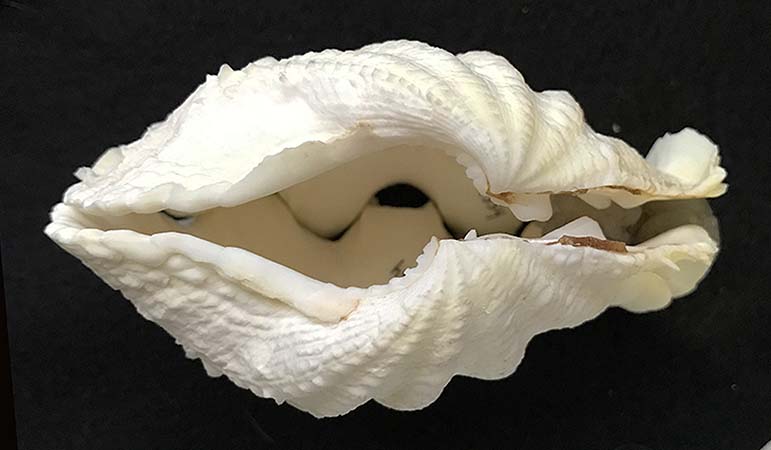The so-called "killer clams" are classified as:
Subclass Heterodonta
Order Cardiida
Family Cardiidae: 7 genera and 3 subgenera
Genus Tridacna Brugiuère, 1797 (the most common genus)
Geologic Range:
Late Cretaceous?, Eocene to Recent, with occurrences in Europe, India, Africa, So. Pacific; commonly associated with corals reefs.
Tridacna clams (bivalves) are generally large to massive in shell size, with ribs few in number but strong, and lacking anterior lateral teeth .
Some species attach themselves via byssal threads to a coral reef, and, in so doing provides stability for themselves. The byssal threads extend through an opening (along a dorsal area located posteriorly) called the byssal notch. The notch can be narrow or very wide. Some individuals use their weight to hold them in place rather than rely on byssal threads. Some individuals can also be nestled among corals. Tridacna bivalves can close their valves for protection, but the closure is rather slow, especially among the large individuals. Their shells do not shut fast like a mousetrap. I think that was the basis for the misconception that these bivalves could trap divers.
Tridacna gigas is the largest of all living bivalves, reaching lengths of more than four feet. Their mature adults can live for nearly a century, and their shells are very heavy.
The edges of their shells are fluted, there by allowing for the flexible mantle to extend upward out of the shell in order to catch sunlight. The mantle contains algae (zooanthellae), which via photosynthesis provides photosynthetic “food” for the bivalve.
Close-up of a living Tridacna specimen with its blue mantle tissue exposed. This specimen was in the same tank of water mentioned above. The mantle contains symbiotic algae which the bivalve eats.
Tridacna maxima (Roding, 1798), Indo Pacific, shallow coral reefs
Three views: exterior and interior of left valve; dorsal view of both valves. Length 9 cm, height 6 cm.
Tridacna (Chametrachea) squamosa Lamarck, 1819. SW Pacific, common. Three views: exterior and interior of left valve; dorsal view of both valves. Length 8.5 cm, height 6.5 cm.
References Used:
Reefkeeping.com (this is a very informative website for the marine aquarist)










No comments:
Post a Comment